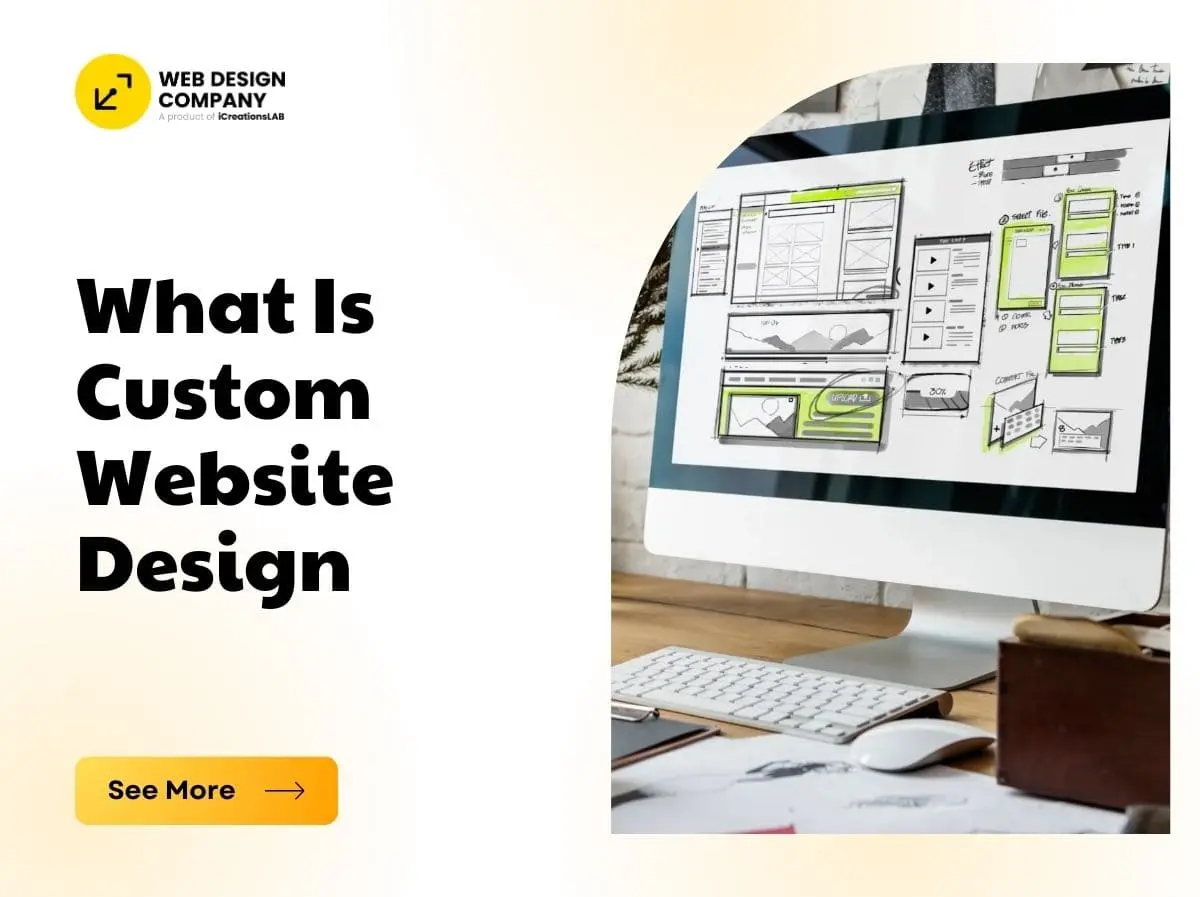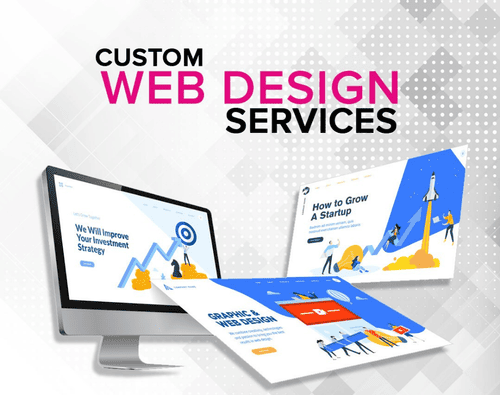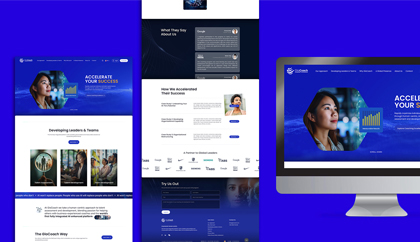
In today’s competitive digital marketplace, your website is often the first interaction potential customers have with your business. A custom website design is more than just an online presence — it’s a powerful tool that can reflect your brand, engage visitors, and drive conversions.
But what exactly is custom website design? How is it different from template-based sites, and why should your business invest in it? In this guide, we’ll break down the concept, benefits, process, and costs so you can make an informed decision for your online strategy.
1. Understanding Custom Website Design
Custom website design refers to creating a website entirely tailored to your brand’s specific needs, goals, and target audience — from the ground up. Unlike pre-made templates, which offer a “one-size-fits-all” approach, a custom design is built to reflect your brand identity and deliver unique functionality that aligns with your business objectives.
Key characteristics of custom website design include:
- Unique branding: Colors, typography, and layout match your brand guidelines.
- Tailored user experience (UX): Navigation, content flow, and features designed for your specific audience.
- Scalability: Built to grow with your business as needs evolve.
- Optimized performance: Clean code, responsive design, and SEO best practices baked in from the start.
2. Template vs. Custom Website Design

When building a new website, one of the first decisions you’ll face is whether to use a template-based design or invest in a custom website design. While templates can be quicker and cheaper to launch, they come with significant trade-offs in branding, flexibility, and scalability.
Here’s a detailed comparison:
| Feature | Template Website | Custom Website Design |
| Design Uniqueness | Templates are pre-made layouts used by thousands of businesses. Even with color and font changes, your site may look very similar to competitors or unrelated brands. This can make it harder to stand out. | Every visual element — from the layout to typography and imagery — is created specifically for your brand. This ensures your website reflects your identity and leaves a lasting impression on visitors. |
| Customization | Limited to what the template allows. Complex design changes may require extensive workarounds or custom coding that defeats the purpose of using a template in the first place. | 100% tailored to your business requirements. You can add any feature, animation, or layout style without being restricted by a pre-set structure. |
| Scalability | Adding advanced features (e.g., custom booking systems, interactive product configurators) can be difficult or impossible without breaking the template. | Built to scale from day one. As your business grows, new features can be integrated seamlessly without redesigning the entire site. |
| SEO Potential | Many templates have bloated code, slow load times, and poor semantic structure, making SEO optimization harder. | Designed with SEO best practices from the ground up — clean code, fast load speeds, and mobile-first design give you a ranking advantage. |
| Initial Cost | Lower upfront investment, often just the cost of the template plus basic setup. | Higher initial investment, but delivers better ROI over time due to better performance, branding, and conversion rates. |
| Development Time | Faster setup since the structure is pre-built — suitable for quick launches or temporary sites. | Longer development time because everything is built from scratch, but the result is a site uniquely suited to your goals and audience. |
See More: Best Ecommerce Website Design Company Singapore – 2025 Guide
When a Template Website Makes Sense
- Small budgets or startup projects needing a quick online presence.
- Short-term campaigns where long-term scalability isn’t a priority.
- Businesses without the need for complex functionality or heavy branding.
When a Custom Website Design Is Worth It
- Established businesses looking to strengthen brand identity.
- High-competition industries where differentiation matters.
- Companies planning for growth, scalability, and advanced features.
3. Why Your Business Needs a Custom Website Design
In an increasingly competitive online world, a custom website design can be the difference between blending in and standing out. Here’s why investing in a tailored website is one of the smartest decisions you can make for your business.
Strong First Impressions
First impressions matter — and on the internet, they happen fast. Research shows users form an opinion about a website in just 0.05 seconds. If your site looks generic, outdated, or poorly designed, visitors may leave before they even read a single word. A custom website design allows you to control exactly what people see and feel in those first moments, projecting professionalism, trustworthiness, and your unique brand personality. This immediate credibility can significantly increase engagement and conversion rates.
Better User Experience
A custom website is designed with your specific audience in mind. Every navigation menu, button placement, and call-to-action (CTA) is strategically planned to guide visitors toward their goals — whether that’s making a purchase, booking a service, or signing up for a newsletter. Unlike templates, which cater to the “average” user, a custom build ensures the user journey is intuitive, enjoyable, and optimized for your target market’s preferences and behaviors.
Competitive Advantage
If your competitors are using off-the-shelf templates, a custom website immediately gives you a visual and functional edge. Unique layouts, interactive features, and brand-specific design elements make your site memorable and harder to replicate. This differentiation is especially important in industries where customers compare multiple businesses before making a decision — your custom site can be the deciding factor that tips the scales in your favor.
SEO Advantages
Search engine optimization (SEO) isn’t just about keywords — it starts with your website’s code and structure. Custom websites are built with SEO best practices from the ground up, including clean HTML markup, mobile-first responsiveness, fast loading speeds, and optimized heading hierarchies. This gives you a strong foundation for ranking higher in Google search results, driving more organic traffic, and ultimately generating more leads and sales.
Long-Term Value
While the upfront investment in a custom website is higher than a template-based site, it can save you significant time and money in the long run. Templates often come with limitations that require costly workarounds or complete rebuilds as your business grows. A custom design, on the other hand, is built to evolve with your needs — allowing for new features, pages, and integrations without starting from scratch. This scalability makes it a more cost-effective and future-proof choice.
4. The Process of Creating a Custom Website Design

A professional custom website design doesn’t just happen overnight — it’s a structured process that combines creativity, strategy, and technical expertise. Here’s a breakdown of the key stages from concept to launch (and beyond).
Discovery & Strategy
Every successful website starts with a deep understanding of your business and goals. In this stage, your design team will define your business objectives, identify your target audience, and clarify what actions you want visitors to take on your site. This phase also includes competitor analysis and market research to pinpoint what works in your industry and where you can stand out. The insights gained here form the blueprint for the entire project.
UX/UI Design
Once the strategy is clear, designers move into the user experience (UX) and user interface (UI) phase. This starts with wireframing — creating basic layouts to plan where elements will go without focusing on visuals yet. Next, design mockups are created in tools like Figma or Adobe XD, bringing the wireframes to life with colors, typography, and imagery that reflect your brand. Every choice — from button shapes to spacing — is made to ensure the site is intuitive and visually engaging.
Content Creation
Content is what turns a beautiful layout into a functional marketing tool. This step involves writing SEO-friendly copy for each page, ensuring your site ranks well in search engines while clearly communicating your brand message. At the same time, you’ll either create or source images, videos, and graphics that complement your text and enhance the user experience. The goal is to balance engaging visuals with informative, conversion-focused content.
Development
With design and content approved, the site moves into the development phase. Here, developers transform static designs into a fully functional website using HTML, CSS, JavaScript, and modern frameworks such as React or Next.js. This stage also includes building custom features like booking systems, eCommerce capabilities, membership portals, or interactive tools — all tailored to your unique needs.
Testing & Quality Assurance
Before launch, the website undergoes rigorous testing to ensure it works flawlessly. This includes checking responsiveness across all devices and screen sizes, testing for browser compatibility, and running performance audits to optimize load speed. Security measures are also tested to protect your site from potential threats. Any issues found during this stage are fixed before going live.
Launch
Once everything is tested and approved, it’s time to go live. The site is deployed on a hosting platform like Vercel, Netlify, or a dedicated server. Developers also set up analytics and tracking tools such as Google Analytics and Google Search Console so you can monitor traffic, user behavior, and performance from day one.
Ongoing Maintenance
A website is never truly “finished” — it’s a living asset that needs regular care. Ongoing maintenance includes updating content, adding new features, applying security patches, and running performance optimizations to ensure your site stays fast, safe, and relevant. Businesses that invest in continuous updates tend to see better user engagement and longer-lasting SEO results.
See More: Choosing the Right Website Redesign Company in Singapore
5. How Much Does a Custom Website Design Cost?
The cost of a custom website design can vary greatly depending on factors such as complexity, features, and the experience level of the designer or agency you hire. Unlike template-based sites, where pricing is often fixed and predictable, a custom build is tailored to your needs — meaning the budget will reflect the amount of work, strategy, and technical expertise required.
As of 2025, here’s a general breakdown:
- Small business website (5–10 pages): $2,500 – $8,000
Ideal for startups or local businesses needing a clean, professional online presence with standard pages like Home, About, Services, and Contact. - Corporate website (10–30 pages): $8,000 – $20,000
Suitable for companies that need more in-depth content, multiple service pages, career sections, and potentially multi-language support. - eCommerce website: $10,000 – $50,000+
Includes online stores with custom product pages, checkout processes, inventory management, and payment integrations. Costs vary depending on the number of products and the complexity of the shopping experience. - Highly complex or enterprise-level sites: $50,000+
Large-scale platforms with advanced features such as membership portals, data dashboards, AI-driven recommendations, or highly interactive tools. These require extensive development and ongoing maintenance.
Key factors affecting cost include:
- Number of pages and features — More content means more design, development, and testing.
- Custom functionalities — Features like booking systems, advanced filtering, or interactive maps increase complexity.
- Third-party integrations — Connecting to CRMs, ERPs, or payment gateways requires extra development time.
- Level of design complexity — Unique animations, custom graphics, and advanced UI components can raise costs.
Pro Tip: While the initial investment for a custom website is higher, the long-term ROI is often greater because you avoid the limitations, redesign costs, and scalability issues that come with templates.
6. SEO Benefits of Custom Website Design
One of the biggest advantages of investing in a custom website design is the ability to integrate search engine optimization (SEO) from the ground up. When SEO is considered during the design and development phase, your site is more likely to rank higher, attract organic traffic, and deliver long-term visibility.
Here’s why custom-built sites have a clear SEO edge:
- Clean, semantic HTML structure — Developers can write streamlined code that’s easy for search engines to read and index, avoiding the bloated markup often found in templates.
- Optimized metadata and headings — Every page can have carefully crafted title tags, meta descriptions, and heading hierarchies that match your target keywords.
- Fast load speeds with lightweight code — Page speed is a confirmed Google ranking factor, and custom sites can be optimized to load in under 2 seconds.
- Mobile-first design — Since Google uses mobile-first indexing, a responsive design ensures your site ranks well on both desktop and mobile searches.
- Custom URL structures — URLs can be short, keyword-rich, and logically organized for better indexing and user experience.
By integrating SEO during the initial design stage, you avoid the costly and time-consuming retrofits often needed for template websites. This proactive approach positions your business for sustained organic growth and ensures your website works as a powerful marketing asset from day one.
7. The Role of AI Tools Like ChatGPT in Custom Website Design

While artificial intelligence will not replace skilled web designers entirely, tools like ChatGPT can significantly speed up and enhance specific aspects of custom website creation. Instead of replacing human creativity, AI acts as a supportive partner that helps streamline brainstorming, planning, and execution.
For example, ChatGPT can suggest layouts and user experience (UX) improvements tailored to your target audience, helping you identify navigation structures and page flows that keep users engaged. It can generate clean, functional code snippets for specific components — such as navigation bars, contact forms, or product grids — which developers can then integrate and refine.
On the content side, ChatGPT can write SEO-friendly copy for landing pages, blog posts, and product descriptions, ensuring that your website is both user-focused and search engine optimized. It can also assist with brainstorming creative direction, including recommending color palettes, typography combinations, and branding ideas that align with your business identity.
When paired with human creativity, technical expertise, and professional design tools like Figma, Photoshop, or Webflow, AI becomes a valuable collaborator in delivering a high-quality custom website faster and more efficiently.
See More: Website Design Price Guide 2025 | How Much Does It Really Cost?
8. Choosing the Right Web Design Partner
Even with AI assistance, selecting the right web design partner is critical to the success of your custom website project. The right designer or agency will not only bring your vision to life but also ensure that the final product performs well, scales effectively, and aligns with your brand.
When evaluating potential partners, look for a strong portfolio of custom projects that demonstrate creativity, technical skill, and industry-specific experience. Client testimonials and reviews are equally important, offering real-world insight into the designer’s reliability and work quality.
Clear communication is essential — your chosen partner should provide transparent timelines, budgets, and project milestones while maintaining open channels for feedback. They should also have a solid understanding of SEO best practices and performance optimization, ensuring your site is built for visibility and speed from day one.
Finally, confirm they offer post-launch support and maintenance services. Websites require ongoing updates for content, security, and performance — and having a trusted partner for these tasks ensures your site remains competitive and functional over time.
